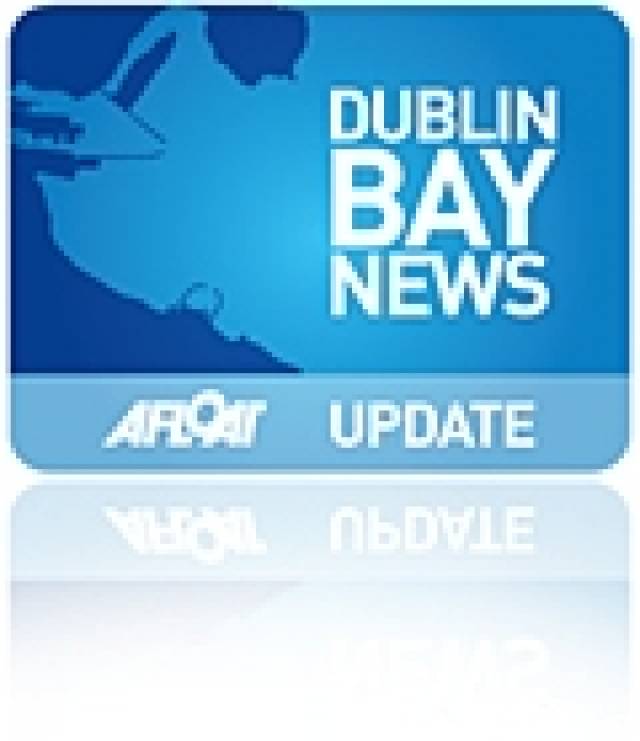The leader of the MOD 70s is 500 miles from Dun Laoghaire after passing the half way point on the 1238 miles stage from Kiel to Dublin this afternoon. The five boat fleet remains very closely matched, all making very similar speeds – around 10-12 knots of boat speed.
As they close the final 50 or so miles to the bottleneck that is formed by the Strait of Dover, the busiest shipping lanes in the world, the 70 foot trimaran fleet on Leg 1 of the MOD70 European Tour has continued to move well considering they have headwinds of less than 10 knots, but they will likely slow down even more before they can escape the worst of the small high pressure cell which is effectively guarding the entrance to the English Channel.
After passing the half way point on the 1238 miles stage from Kiel to Dublin, the fleet remains very closely matched, all making very similar speeds – around 10-12 knots of boat speed.
Winds may be light but the pressure remains very intense on this second full afternoon at sea. Knowing that whichever crew can break through the barrier of light winds first and escape into the channel might gain the decisive advantage. Once through the light winds zone the leaders will break into a progressively building breeze from the N'ly quadrant. Accelerating faster and faster, with the prospect of completing the Dover to Land's End passage in some 12-14 hours, the key tactic this Tuesday afternoon is not to be left behind in the Strait.
Brian Thompson from Musandam-Oman Sail reported this morning: "Everyone is concentrating on getting the best speed out of the boat, and we can see that today is a critical day as the wind is going to fall sharply near the Thames Estuary and the fleet is likely to compress. Who gets out of the light patch first may have a lead till approaching Ireland.".
And the fleet remains very closely matched: "We saw Groupe Edmond de Rothschild in the morning yesterday; and although we went entirely different routes all day, and were up to 50 miles apart, we saw them again in the evening! This morning we can see them about 6 miles away - exciting racing." Continued Thompson.
Seeking a chance of additional thermal sea-breeze activity closer to the coast is one possible strategy, but conversely those erring too close to the high land may also lose out when the breeze blows from the forecasted more offshore direction.
Spindrift racing, the leaders since the first night of racing, continued to hold a delta of about five miles on second place, but Sebastien Josse's Groupe Edmond de Rothschild has made a good inroad into FONCIA during the late morning and afternoon and were less than half a mile behind Michel Desjoyeaux's crew.
Having proven a thorn in the side for the FONCIA crew in last month's KRYS OCEAN RACE, it will have been a source of some bemusement to again see Groupe Edmond de Rothschild's dark blue pattern sails looming ever larger from the horizon today.
Guichard and crew on Spindrift racing have split closer to the English coast mid afternoon, diverging temporarily away from the second and third placed MOD70's engaged in a Pas de Deux in the final reaches of the Pas du Calais. But with just 23 miles between first and fifth placed Race for Water, the fleet remains tightly grouped.
Ravussin's Race for Water struggled with an electronics problem, which has meant they were initially unable to get and use high-resolution weather information. This compounded their initial errors, struggling with a bad sail change during the first late evening. But from being more than 70 miles behind, Ravussin, Cammas, Coville and Co have kept chipping away and are now very much in touch with the leaders and passed Musandam-Oman Sail to steal fourth. "We have sailed less than our rivals and so it does not come so easily, but we are getting there." Reassured Ravussin when contacted at midday.
Standings at 12h45 UTC 4th September
1- Spindrift racing (Yann Guichard) at 504,4 miles from Dun Laoghaire
2- FONCIA (Michel Desjoyeaux) at 7,1 miles from leader
3- Groupe Edmond de Rothschild (Sébastien Josse) at 7,4 miles from leader
4- Race for Water (Stève Ravussin) at 14,1 miles from leader
5- Musandam-Oman Sail (Sidney Gavignet) à 16 miles du leader

























